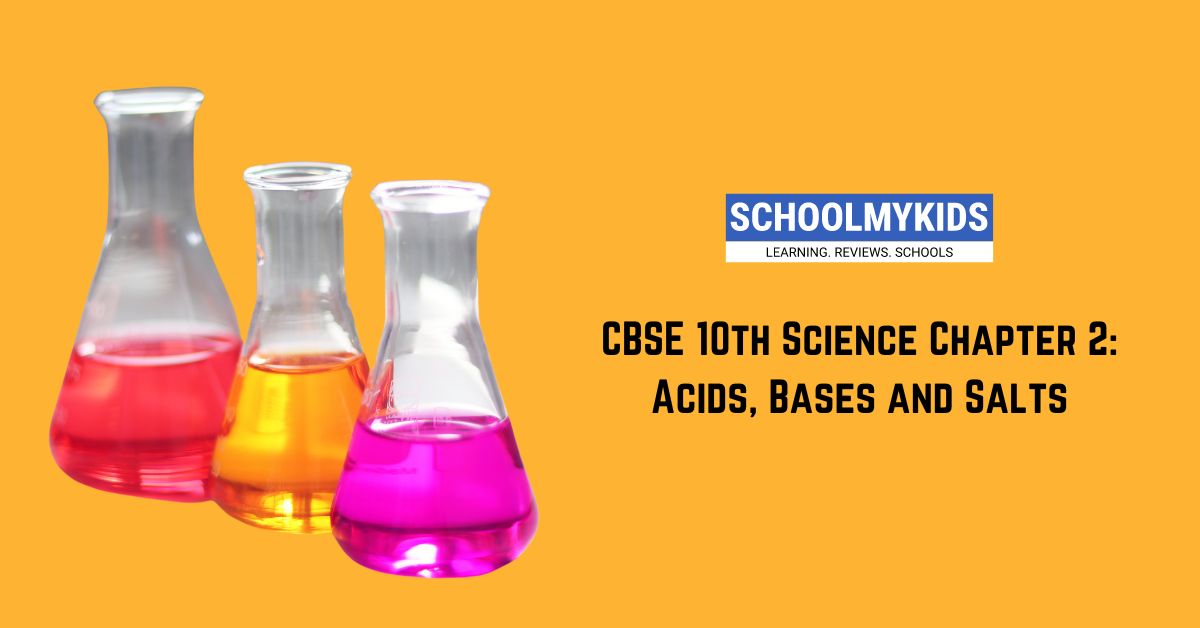This chapter of CBSE Class 10th Science syllabus explores the fundamental properties, behaviors, and interactions of acids, bases, and salts, which are essential building blocks in chemistry.
2.1 Understanding Acids and Bases
- Definition of Acids:
- Brønsted-Lowry Definition (focus on proton transfer)
- Lewis Definition (focus on electron pair acceptance)
- Common characteristics of acids (sour taste, turn litmus red, react with metals to produce hydrogen gas)
- Definition of Bases:
- Brønsted-Lowry Definition (focus on proton acceptance)
- Lewis Definition (focus on electron pair donation)
- Common characteristics of bases (bitter taste, turn litmus blue, slippery feel)
- The pH Scale:
- A measure of the concentration of hydrogen ions (H+) in a solution.
- Ranges from 0 (very acidic) to 14 (very basic), with 7 being neutral.
- Importance of pH in various fields (chemistry, biology, environmental science).
2.2 Reactions of Acids and Bases
- Neutralization Reactions:
- Reaction between an acid and a base to form a salt and water.
- Importance of neutralization in everyday life (antacids, soil treatment).
- Indicators:
- Substances that change color in response to the acidity or alkalinity of a solution (e.g., litmus paper, phenolphthalein).
- Types of indicators (acid-base indicators, universal indicators).
2.3 Properties and Uses of Salts
- Definition of Salts:
- Ionic compounds formed by the reaction of an acid and a base.
- Properties of salts (can be soluble or insoluble in water, can conduct electricity in solution).
- Types of Salts:
- Classification based on the cation (positive ion) and anion (negative ion)
- Examples: sodium chloride (NaCl), calcium carbonate (CaCO₃), potassium nitrate (KNO₃)
- Importance of Salts:
- Applications in various fields (food additives, electrolytes, road deicing).
2.4 Strength of Acids and Bases
- Strong Acids and Bases:
- Completely dissociate in water to form large amounts of ions.
- Examples: hydrochloric acid (HCl), sodium hydroxide (NaOH)
- Weak Acids and Bases:
- Partially dissociate in water, resulting in a lower concentration of ions.
- Examples: acetic acid (CH₃COOH), ammonia (NH₃)
- Factors Affecting Acid Strength:
- Bond strength between hydrogen and the acidic group.
- Stability of the anion formed after dissociation.
2.5 Applications of Acids and Bases
- Acids and Bases in Everyday Life:
- Food industry (citric acid in fruits, baking soda for leavening)
- Cleaning products (vinegar, bleach)
- Biological systems (stomach acid, regulation of body pH)
- Industrial Applications of Acids and Bases:
- Production of fertilizers, chemicals, and materials
2.6 Brønsted-Lowry Acid-Base Theory vs. Lewis Acid-Base Theory (Optional)
- A brief comparison of the two prominent theories explaining acid-base behavior.
- Highlighting the key differences and how they complement each other.
Questions and Answers:
2.1 Understanding Acids and Bases
- What household product has acidic properties and can be used to add a sour taste to food?
- Answer: Vinegar! Vinegar contains acetic acid, a weak acid that contributes to its sour taste.
- You have a solution that turns litmus paper red. Can you tell if it’s definitely an acid?
- Answer: Litmus paper is a good indicator, but not definitive. Other substances like some acidic salts can also turn litmus red. We can use the pH scale for a more precise measurement.
- According to the Brønsted-Lowry definition, what happens to an acid molecule in water?
- Answer: In the Brønsted-Lowry theory, an acid donates a proton (H+) to a water molecule (H₂O). The acid becomes a conjugate base after donating the proton.
- What property distinguishes a base from an acid according to the Lewis definition?
- Answer: In the Lewis theory, a base is an electron pair donor. It can accept a vacant orbital from a Lewis acid (electron pair acceptor). 6
2.2 Reactions of Acids and Bases
- When you take an antacid to relieve heartburn, what kind of chemical reaction is likely happening?
- Answer: Antacids are basic substances (often metal hydroxides like magnesium hydroxide). They react with the excess stomach acid (containing H+ ions) in a neutralization reaction to form water and a salt.
- What is the role of an indicator in an acid-base reaction?
- Answer: An indicator is a chemical compound that changes color depending on the acidity or alkalinity of a solution. It helps us visually identify if a solution is acidic, basic, or neutral.
- Phenolphthalein is a common indicator. What color does it turn in a basic solution?
- Answer: Phenolphthalein is a popular acid-base indicator. In a basic solution (with a high pH), it turns pink.
- Why is it important to neutralize spilled acid or base?
- Answer: Concentrated acids and bases can be corrosive and damage surfaces or injure skin. Neutralization helps reduce their harmful effects by converting them into less reactive salts.
2.3 Properties and Uses of Salts
- Table salt (NaCl) readily dissolves in water, but calcium carbonate (CaCO₃) used in eggshells does not. Why the difference?
- Answer: Solubility of salts depends on various factors. Sodium chloride is a highly ionic compound and readily dissolves in water. Calcium carbonate has a different ionic structure that makes it less soluble.
- How can the electrical conductivity of a solution help determine if it contains a salt?
- Answer: Salts dissociate in water to form ions. These ions conduct electricity. Measuring the electrical conductivity of a solution can be an indicator of the presence of dissolved salts.
- Baking soda (sodium bicarbonate) is a common household item. Can you classify it as acidic, basic, or a salt?
- Answer: Sodium bicarbonate is a salt. It’s formed from the reaction of a base (sodium hydroxide) and carbonic acid









Be the first one to comment on this story.